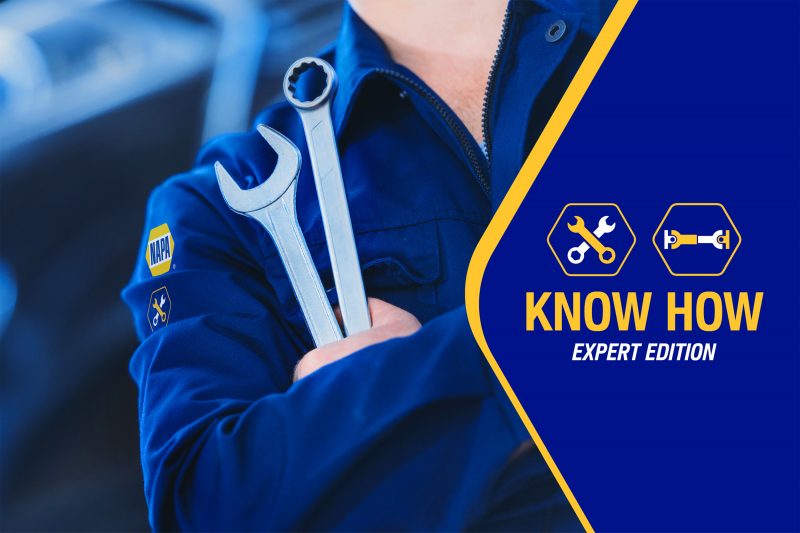
Know How – Expert Edition – Wheel Bearing Designs
21 Jun 2021
Category:
With Andy Minns
Andy is about as well-versed in transmission parts as one can get, with several years of experience to his name. In this transmission-focused Know How Expert Edition, he will be sharing some of that practised expertise with us to explain the different variations of wheel bearings and how each one has been specifically tailored to suit a range of unique vehicle applications. If you would like to learn even more about NAPA transmission, contact the NAPA technical helpline at 03333 136597 to speak to one of our automotive professionals.
INTRODUCTION
Being able to identify the different wheel bearing designs and how to replace them is an invaluable skill for any technician, especially when it comes to removal and installation practices. Each wheel bearing design is tailored to supporting unique vehicle configurations, which means a trained knowledge of each design you might encounter could save you time and effort at the repair stage.
SINGLE ROW BEARINGS
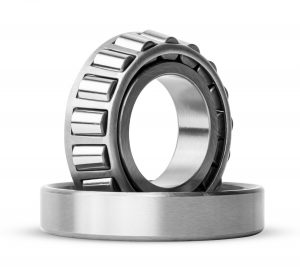 The first wheel bearings (circa 1794) used a single row of ball bearings and, as speeds and vehicle loads increased, single row roller bearings were introduced for use in different vehicle applications. As the demands of the front and rear wheel bearings are different, taper roller bearings were developed to cope with the axial loads on the front wheels. Though not necessarily obsolete, they are not commonly used in modern vehicles and require strict adherence to OEM installation instructions, especially with regards to torque settings. This is because excessive torque can lead to excessive pre-load, while insufficient torque can cause issues with endplay.
The first wheel bearings (circa 1794) used a single row of ball bearings and, as speeds and vehicle loads increased, single row roller bearings were introduced for use in different vehicle applications. As the demands of the front and rear wheel bearings are different, taper roller bearings were developed to cope with the axial loads on the front wheels. Though not necessarily obsolete, they are not commonly used in modern vehicles and require strict adherence to OEM installation instructions, especially with regards to torque settings. This is because excessive torque can lead to excessive pre-load, while insufficient torque can cause issues with endplay.
As these can both be a cause of wheel bearing failure, it is important when removing and installing all wheel bearings to use specialist tools that will allow for the even distribution of force across the entire surface area of the bearing. Doing so will minimise the risk of an uneven road and lead to a smoother drive overall. Remember: directly impacting the inner race of any wheel bearing can cause significant damage to the wheel bearing, so be sure to avoid brute force when removing and installing.
DUAL ROW BEARINGS
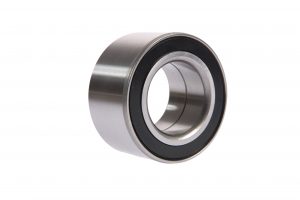 As demands on vehicles increased, dual row angular contact ball and dual row taper roller bearings were designed to be used in both driven and non-driven axle vehicles. Pre-lubricated and sealed for ‘maintenance-free’ operation, these bearings did not have flanges, allowing them to be fitted into the bearing carrier when installed into the front axle. When press-fitting these bearings into the bearing carrier, pressure must be evenly applied solely to the outer ring. When pressing the wheel bearing hub into the inner ring, however, pressure should only be applied to both the hub and the inner ring.
As demands on vehicles increased, dual row angular contact ball and dual row taper roller bearings were designed to be used in both driven and non-driven axle vehicles. Pre-lubricated and sealed for ‘maintenance-free’ operation, these bearings did not have flanges, allowing them to be fitted into the bearing carrier when installed into the front axle. When press-fitting these bearings into the bearing carrier, pressure must be evenly applied solely to the outer ring. When pressing the wheel bearing hub into the inner ring, however, pressure should only be applied to both the hub and the inner ring.
After removing an old dual row bearing, make sure to check for dark patches in the bearing seat – these indicate oval forming, which means the bearing carrier should be replaced for bearing security. For vehicle applications containing a magnetic encoder as part of an ABS, ensure that the multipole encoder faces inwards towards the sensor to prevent magnetic interference. Avoid using a metal impregnated lubricant during fitting, as this can also lead to interference.
FLANGE BEARINGS
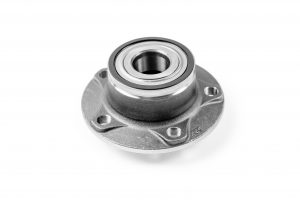 As vehicle assembly and manufacturing tolerances improved, wheel bearings consisting of either a wheel/drive flange or mounting flange with an integrated dual row ball/taper bearing were introduced. The compact integration of these bearings allows for fewer individual parts and more rigidity with the trade-off of requiring dedicated tools for press-fitting the bearing into the bearing seat by applying pressure to the outer ring. When pressing the bearing of flange bearings it is vital to use a clamp to ensure the snap ring (where fitted) is fully locked in place. This prevents the loosening of the bearing in transit, which could lead to a potentially fatal accident.
As vehicle assembly and manufacturing tolerances improved, wheel bearings consisting of either a wheel/drive flange or mounting flange with an integrated dual row ball/taper bearing were introduced. The compact integration of these bearings allows for fewer individual parts and more rigidity with the trade-off of requiring dedicated tools for press-fitting the bearing into the bearing seat by applying pressure to the outer ring. When pressing the bearing of flange bearings it is vital to use a clamp to ensure the snap ring (where fitted) is fully locked in place. This prevents the loosening of the bearing in transit, which could lead to a potentially fatal accident.
DUAL FLANGE BEARINGS
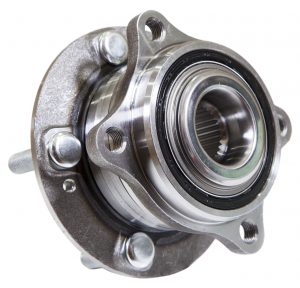
Over time the need to increase the speed of assembly and repair while reducing costs led to the development of wheel bearings equipped with two flanges and either a double row ball or taper roller pre-assembled bearing. These bearings often incorporate ABS sensors or magnetic seals for precision speed measurement, allowing them to facilitate ABS, ESP and Electric Traction Control functions. They also reduce hub/brake disc run out with enhanced braking efficacy and possess a simpler fitting procedure than preceding bearings. Using OEM specified tightening torques is key to the installation process for these bearings. Some dual flange bearings have a thicker flange and a bigger outer race for improved rigidity.
Did you know?
Taper roller wheel bearings require specialised grease of application-specific grades to function at maximum efficiency. Making certain that a wheel bearing is lubricated and greased is known as “wheel bearing packing”.
Become a NAPA Stockist Download PDF Guide
Chevrolet Spark Clutch Fitment Guide
A rattle generated from the clutch fork/release bearing area may be evident after a new...
Read MoreKia Sportage Clutch Fitment Guide
When installing a new clutch kit to the Kia Sportage CRDI (1.7, 2010-2015), you may...
Read MoreFuel Filter Fitment Guide - NFF2122
When replacing the fuel filter, it’s important to ensure correct fitment is followed. Keep the...
Read More